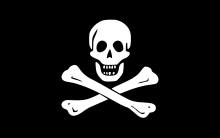
Back إدوارد إنجلاند Arabic Edward Seegar Czech Edward England German Edward England Spanish Edward England Estonian ادوارد انگلاند Persian Edward England Finnish Edward England French אדוארד אינגלנד HE Edward England Italian
Edward England | |
|---|---|
 An 18th century woodcut of England | |
| Born | c. 1685 |
| Died | 1720/21 (aged approximately 36) |
| Piratical career | |
| Nickname | Ned |
| Type | Pirate Former privateer |
| Allegiance | Kingdom of Great Britain (War of the Spanish Succession) |
| Rank | Captain |
| Base of operations | Southern Africa |
| Commands | Several vessels, most famously the Royal James and the Fancy. |
| Battles/wars | Battle with the Cassandra that caused his crew to mutiny and maroon him for sparing some captives. |
| Wealth | R 10,000,000 |

Edward England (c. 1685–1721)[1][2] was an Irish pirate. The ships he sailed on included the Pearl (which he renamed The Royal James) and later the Fancy, for which England exchanged the Pearl in 1720. His flag was the classic Jolly Roger — almost exactly as the one "Black Sam" Bellamy used — with a human skull above two crossed bones on a black background. Like Bellamy, England was known for his kindness and compassion as a leader, unlike many other pirates of the time.
England was born Edward Seegar in Ireland around 1685. He took part in Henry Jennings' expedition for the sunken 1715 Treasure Fleet off the coast of Florida, and then began sailing with Charles Vane in 1718. Upon Vane and other prominent pirates accepting the King's Pardon, England and some of his men sailed for Africa. Along his way he spawned the career of Bartholomew Roberts, among others. In 1720, near the African island of Comoros, England and his men got into a violent conflict with James Macrae. After 10 days of hiding on an island, England and Macrae agreed to a peace deal, upsetting England's crew; he was subsequently voted out as captain and marooned on the island of Mauritius. After four months, England and the loyal crewman that had been stranded with him managed to build a boat and sail to a pirate safe haven in Madagascar. He died sometime in the winter of 1720–21, possibly from tropical disease.